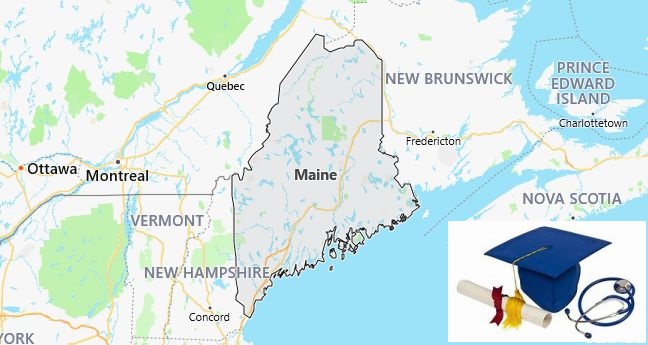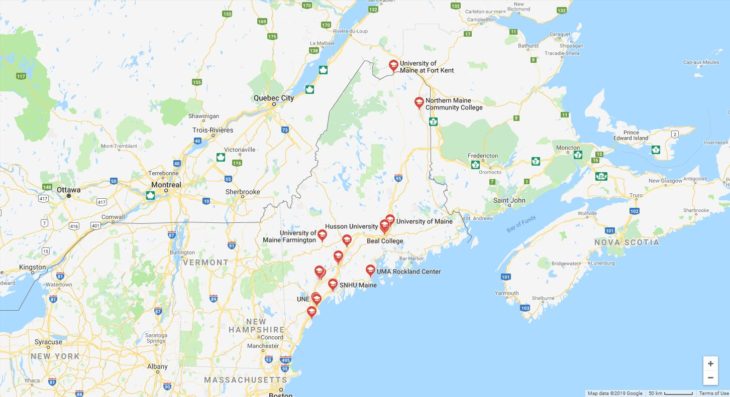If you intend to purse a nursing degree in Maine, you should aim at the top nursing schools in Maine. Let’s show below, which schools have a standard curriculum for nursing education and are recognized by the market.
See the latest nursing school ranking of the state and check the top nursing colleges among the institutions and the best evaluated courses in Maine.
List of Best Nursing Colleges in Maine
| Rankings | Nursing Universities | Nursing Colleges |
| 1 | University of Southern Maine Mailing Address: 96 Falmouth Street, Portland, ME 04104-9300 Phone Number: (207) 780-4505 E-mail: con@usm.maine.edu Website Homepage: http://www.usm.maine.edu/conhp/nursing/degrees.html |
College of Nursing and Health Professions |
| 2 | University of Maine Mailing Address: 5724 Dunn Hall, Orono, ME 04469-5724 Phone Number: (207) 581-2592 E-mail: nursing@maine.edu Website Homepage: http://www.umaine.edu/nursing/gradprg.htm |
School of Nursing |
| 3 | St. Joseph’s College Mailing Address: 278 Whites Bridge Road, Standish, ME 04084-5263 Phone Number: (207) 893-7841 E-mail: info@sjcme.edu Website Homepage: http://www.sjcme.edu/gps/nursingrequirements.htm |
Department of Nursing |
| 4 | Husson University Mailing Address: 1 College Circle, Bangor, ME 4401 Phone Number: (202) 941-7166 E-mail: harveyj@husson.edu Website Homepage: http://www.husson.edu/index.php?cat_id=428 |
School of Health |

History of the Great Seal of the United States
Charles Thomson, an outstanding politician of the young North American state, is deservedly considered the “father” of the Great Seal of the United States.
On July 4, 1776, thirteen North American states declared independence from Great Britain. On the same day, the Continental Congress (the forerunner of the modern United States Congress), which led the new state, created a committee to design a national emblem, the symbol that the Great Seal of the United States was to become. This committee included three of the five main authors of the US Declaration of Independence: Benjamin Franklin, Thomas Jefferson, and John Adams.
Six years passed and the first committee to create the Great Seal of the United States was replaced by a second, and then a third. In 1782, the Continental Congress commissioned the design of the Great Seal of the United States to the Secretary of Congress, Charles Thomson.
Charles Thomson studied the proposals of all three committees and added his own. On June 20, 1782, he addressed Congress with a description of his vision for the main seal of the country. On the same day, Thomson’s proposals were passed by Congress.
The Great Seal of the United States was first used by Charles Thomson on September 16, 1782 to certify a document that authorized George Washington to negotiate a prisoner exchange.
Charles Thomson, as Secretary of Congress, remained Keeper of the Great Seal of the United States until the formation of the federal government. On July 24, 1789, at the request of the first President of the United States, George Washington, Charles Thomson handed over the Great Seal of the United States to the United States Department of State.
Since 1935, both sides of the Great Seal of the United States have been featured on the US$1 note. This decision was made by the thirty-second President of the United States, Franklin Delano Roosevelt, on the advice of the then Minister, and in the future Vice President of the United States, Henry Wallace. Roosevelt pursued what was called the “New Deal” and the motto Novus Ordo Seclorum (“Order of the New Era”) on the Great Seal of the United States was very much in keeping with its promotion.
A hand press made in 1903 is used to imprint the Great Seal of the United States on a document. The matrix of the Great Seal of the United States, which is in use today – the seventh in a row for the entire existence of the press, it was made in 1986. Now the Great Seal of the United States is used approximately two to three thousand times a year.

